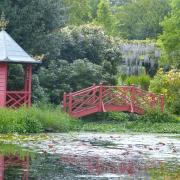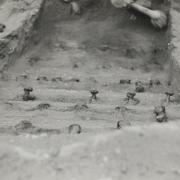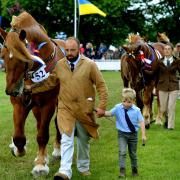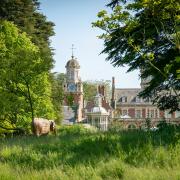The discoveries at Sutton Hoo lifted the veil on the so-called Dark Ages. What better place to be at the dawn of a new year?
A new year dawns . . . where do you want to be at that moment? Well, perhaps not at that exact moment, but in the first few hopeful days of a new year. I decided it was Sutton Hoo. I confess, I have a fascination for the place.
I lived for a few years in Japan. I found it to be a society of two halves, on the one hand rushing to embrace the new, on the other cleaving to long-held traditions. Festivals are frequent - there's always some aspect of spiritual life or nature to celebrate. For me, by far the most endearing is the annual Obon festival, three or four days in August, when Japanese people travel to their home towns to pay respect to their deceased ancestors.
The tradional belief is that the spirits of their forebears return at this time to visit their relatives. People hang Chochin (paper) lanterns to guide the spirits and perform Obon dances (bon odori). I find this very poignant - showing honour, respect and gratitude to those who've gone before us (maybe even forgiveness for some things).

And that's what I find myself mulling over as I wander around Sutton Hoo. We're always walking among the fabric of history, but Sutton Hoo isn't about buildings. This is the burial site of a notable Anglo-Saxon, probably a king of East Anglia. I'm an East Anglian, so this is my ancestry. Once you stop thinking of Sutton Hoo as a few hillocks on the horizon and start understanding what went on here in the 7th century, you begin to make a few connections. It's an Obon experience, of sorts.
Sutton Hoo is a 255 acre estate, on the gentle slopes of the River Deben valley. It's where one of the greatest archaeological discoveries of all time was made, an Anglo-Saxon burial ground that includes a great ship burial thought to be that of King Rædwald of East Anglia. Part of the ruling Wuffingas dynasty, who claimed descent from the Germanic god Woden, Raedwald was esteemed enough to warrant a magnificent send-off.

This involved bringing his 90ft (27m) ship down the river from Rendlesham - a known residence of East Anglian kings - and dragging it up the Sutton Hoo side of the valley, a considerable feat for a team of devoted subjects. Here king and ship were entombed in a mound, or 'barrow', with an impressive collection of jewellery, ceremonial symbols of office, silver bowls, drinking vessels, clothing and weaponry, and the iconic Sutton Hoo helmet.


Uncovering Sutton Hoo has hugely increased our knowledge of our Anglo-Saxon ancestors, the world they created and the times in which they lived. The burial that took place here was a spectacular public event, intended to be remembered for all time, rather like another, more recent, memorable royal funeral . . .
The walks
Sutton Hoo any time of the year is fantastic but it's particularly good in winter when you can wander the estate with just a handful of others for company. In the off-season, the National Trust site is partially open. Monday to Friday, the estate walks and Keepers' café (next to Tranmer House) are open with no entry fee, although you'll need to pay for car parking, while the High Hall exhibition, Tranmer House, café, shop and bookshop are open at the weekends. The whole site is fully open between December 26 and January 2, though, so if you're at a loose end it's a great family day out.

Ferry Cliff Walk
There are several trails you can follow, all signposted. The Ferry Cliff Walk is about 3 miles (4.7km) and is quite steep in places. It covers the bounds of the estate, more or less, and takes up to two hours, depending how many times you stop to take photographs.
Start at the main entrance to Sutton Hoo, go through the courtyard and past the sculpture of the Great Ship Burial, then head down the valley in front of you, following the path. When you reach a T-junction at the bottom, turn left and follow the path past the dairy farm on the right-hand side. Immediately after the farm, take the signed footpath on the right, following it between gardens.

You then cross a meadow and climb the path to the river wall. There are lovely views of the River Deben here. Turn left and follow the path along the river wall to Ferry Cliff Woods. At the end of Ferry Cliff climb the steps, turn left and take the steps to the top of the cliff. Turn left, follow the bridle path to the right around the edge of the woods keeping to the treeline. At end of the field, a track goes through the trees. Don't take this but turn right and follow the track along the field with the wood on your left.
When you reach the end of the wood, follow the path across the field to a gap in the hedge and turn left onto a sealed bridleway. When you reach the estate road, follow it until you reach the main road (about a mile). Turn left to carefully follow the road for about 250 yards. When you reach the end of the woods, turn left and follow the track to the top of the field. At the top of the field you'll see a National Trust sign. Go past it and head sharp right through the gate. Follow the path back towards Tranmer House.
Riverview walk and the way to the burial ground
For this visit to Sutton Hoo I decided to do two shorter walks, each taking about 45 minutes. The River View walk starts off along the same path as the Ferry Cliff walk, but cuts up the side of the valley and through woods. Amid the amber and copper leaves of autumn, I encountered some unflappable little muntjac which simply stood and watched as I gazed out at a splendid view of the River Deben, and Woodbridge nestling on the other side.


This walk takes you through pine woods, with Anglo-Saxon inspired markers along the way, back to the cafe and courtyard. I then headed off to the burial ground, via the valley between two 'hoos'. Is this where they dragged the ship from the river? Hoo is the Anglo-Saxon word for a spur of land or ridge. Tranmer House sits atop one of them; the other is the way to the burial ground. Heading left at the bottom of the valley, the climbs, crossing the Ferry Cliff Walk, and up through woods to the new viewing tower.

At 17 metres high (81 steps) the tower really helps you to appreciate the extent of the burial ground and its proximity to the river. Suddenly it all makes sense.
Visit Sutton Hoo nationaltrust.org.uk/visit/suffolk/sutton-hoo




























